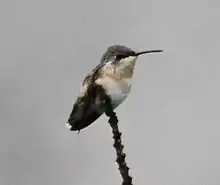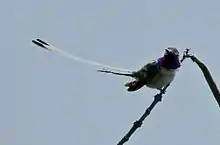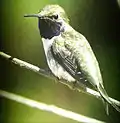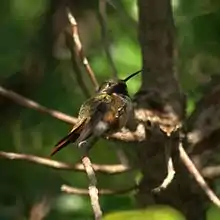Mellisugini
Mellisugini is one of the three tribes that make up the subfamily Trochilinae in the hummingbird family Trochilidae. The other two tribes in the subfamily are Lampornithini (mountain gems) and Trochilini (emeralds).
| Mellisugini | |
|---|---|
_adult_male_non-breeding.jpg.webp) | |
| Bee hummingbird (Melisuga helenae) | |
| Scientific classification | |
| Kingdom: | Animalia |
| Phylum: | Chordata |
| Class: | Aves |
| Order: | Apodiformes |
| Family: | Trochilidae |
| Subfamily: | Trochilinae |
| Tribe: | Mellisugini Reichenbach, 1854 |
| Genera | |
|
16, see text | |
The informal name "bees" has been proposed for this group as it includes the tiny bee hummingbird (Mellisuga helenae) that is endemic to Cuba.[1]
Phylogeny
A molecular phylogenetic study of the hummingbirds published in 2007 found that the family was composed of nine major clades.[4] When Edward Dickinson and James Van Remsen, Jr. updated the Howard and Moore Complete Checklist of the Birds of the World for the 4th edition in 2013 they based their classification on these results and placed three of the nine clades in the subfamily Trochilinae. The clades were placed in separate tribes which they named Mellisugini (bees), Lampornithini (mountain gems) and Trochilini (emeralds).[5] The tribe Mellisugini with the current circumscription was introduced in 2009.[6] A subfamily Mellisuginae had been introduced by the German naturalist Ludwig Reichenbach in 1854.[7]
| Trochilidae |
| ||||||||||||||||||||||||||||||||||||||||||||||||
The above cladogram of the hummingbird family is based on molecular phylogenetic studies by Jimmy McGuire and collaborators published between 2007 and 2014.[2][4][6] The English names are those introduced in 1997.[1] The Latin names are those proposed by Dickinson and Remsen in 2013.[8]
| Mellisugini |
| |||||||||||||||||||||||||||||||||||||||||||||||||||||||||||||||||||||||||||||||||||||||||||||||||||
The above cladogram shows the relationships between the genera and is based on a molecular phylogenetic study by Yuyini Licona-Vera and Juan Francisco Ornelas published in 2017.[9] The results are in agreement with the phylogeny by Jimmy McGuire and collaborators published in 2014.[2]
The genus Calliphlox was found to be polyphyletic. As part of the revised classification to create monophyletic genera, the Bahama woodstar and the Inagua woodstar were moved to the resurrected genus Nesophlox.[3] Proposals have been submitted to the classification committees of the American Ornithological Society to resurrect of the genus Philodice to accommodate the purple-throated woodstar and the amethyst woodstar.[10][11]
The genus Atthis containing the wine-throated hummingbird and the bumblebee hummingbird was embedded within Selasphorus.[2][9] The genera were therefore merged and as under the rules of the International Code of Zoological Nomenclature Selasphorus has priory over Atthis the two species were moved to Selasphorus.[3]
Distinguishing features
Hummingbirds in the tribe Mellisugini have sexually dimorphic tails. Only male birds have specialized tail feathers that produce sounds during their courtship display.[12]
The only migratory hummingbirds are found in this tribe. Remarkable examples are the rufous hummingbird (Selasphorus rufus) that breeds as far north as western Canada and Alaska and overwinters in Mexico and the ruby-throated hummingbird (Archilochus colubris) that breeds in the eastern United States and then crosses the Gulf of Mexico to winter in Mexico and Central America. There are five other long-distance migrants in the tribe: the broad-tailed hummingbird (Selasphorus platycercus), the calliope hummingbird (Selasphorus calliope), Allen's hummingbird (Selasphorus sasin), the black-chinned hummingbird (Archilochus alexandri) and the lucifer sheartail (Calothorax lucifer). It is likely that migratory behaviour has evolved several times.[9]
Taxonomic list
The tribe contains 16 genera.[3]
References
- Bleiweiss, R.; Kirsch, J.A.; Matheus, J.C. (1997). "DNA hybridization evidence for the principal lineages of hummingbirds (Aves:Trochilidae)". Molecular Biology and Evolution. 14 (3): 325–343. doi:10.1093/oxfordjournals.molbev.a025767.
- McGuire, J.; Witt, C.; Remsen, J.V.; Corl, A.; Rabosky, D.; Altshuler, D.; Dudley, R. (2014). "Molecular phylogenetics and the diversification of hummingbirds". Current Biology. 24 (8): 910–916. doi:10.1016/j.cub.2014.03.016.
- Gill, Frank; Donsker, David; Rasmussen, Pamela, eds. (July 2020). "Hummingbirds". IOC World Bird List Version 10.2. International Ornithologists' Union. Retrieved 10 January 2020.
- McGuire, J.A.; Witt, C.C.; Altshuler, D.L.; Remsen, J.V. (2007). "Phylogenetic systematics and biogeography of hummingbirds: Bayesian and maximum likelihood analyses of partitioned data and selection of an appropriate partitioning strategy". Systematic Biology. 56 (5): 837–856. doi:10.1080/10635150701656360.
- Dickinson & Remsen 2013, p. 133.
- McGuire, J.A.; Witt, C.C.; Remsen, J.V.; Dudley, R.; Altshuler, D.L. (2009). "A higher-level taxonomy for hummingbirds". Journal of Ornithology. 150 (1): 155–165. doi:10.1007/s10336-008-0330-x.
- Reichenbach, Ludwig (1854). "Aufzählung der Colibris Oder Trochilideen in ihrer wahren natürlichen Verwandtschaft, nebst Schlüssel ihrer Synonymik". Journal für Ornithologie (Supplement) (in German). 1: 1-24 [6].
- Dickinson & Remsen 2013, pp. 105–136.
- Licona-Vera, Yuyini; Ornelas, Juan Francisco (2017). "The conquering of North America: dated phylogenetic and biogeographic inference of migratory behavior in bee hummingbirds". BMC Evolutionary Biology. 17 (1): 126. doi:10.1186/s12862-017-0980-5.
- Donsker, David B.; Rasmussen, Pamela C.; Mason, Nicholas A. (September 2020). "Proposal 886: Resurrect Philodice as a separate genus from Calliphlox". South American Classification Committee, American Ornithological Society. Retrieved 12 January 2020.
- Donsker, David B.; Rasmussen, Pamela C.; Mason, Nicholas A. (8 September 2020). Proposal 2021-A-12: Resurrect Philodice as a separate genus from Calliphlox (PDF) (Report). North American Classification Committee, American Ornithological Society. pp. 63–66.
- Clark, C.J.; Elias, D.O.; Prum, R.O. (2011). "Aeroelastic flutter produces hummingbird feather songs". Science. 333 (6048): 1430–1433. doi:10.1126/science.1205222.
Sources
- Dickinson, E.C.; Remsen, J.V., Jr., eds. (2013). The Howard & Moore Complete Checklist of the Birds of the World. Volume 1: Non-passerines (4th ed.). Eastbourne, UK: Aves Press. ISBN 978-0-9568611-0-8.
.jpg.webp)
.jpg.webp)




_(8077616362).jpg.webp)
_2015-06-16_(3)_(26457944788).jpg.webp)


.jpg.webp)
.jpg.webp)

%252C_male_(4205673916).jpg.webp)
